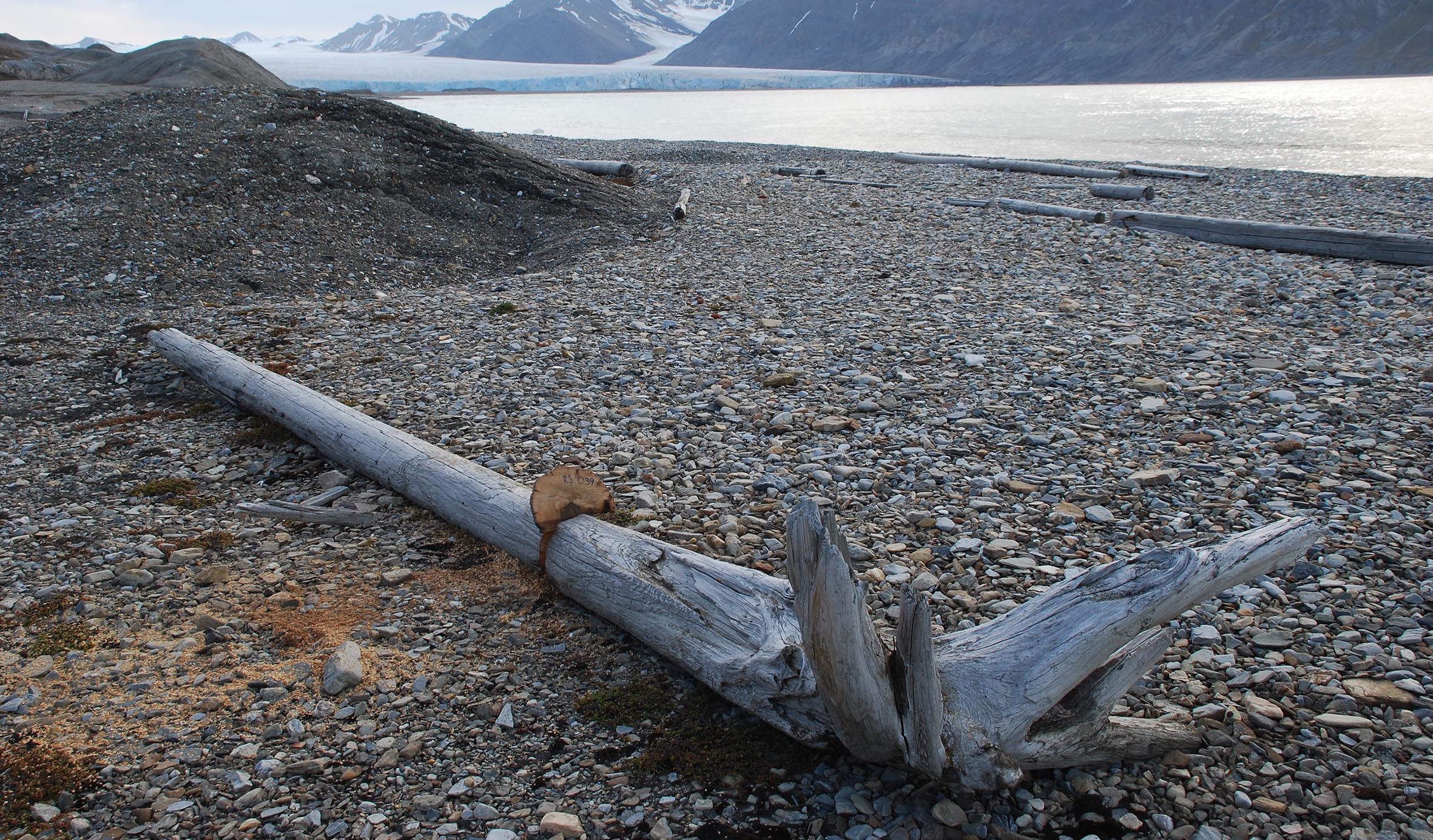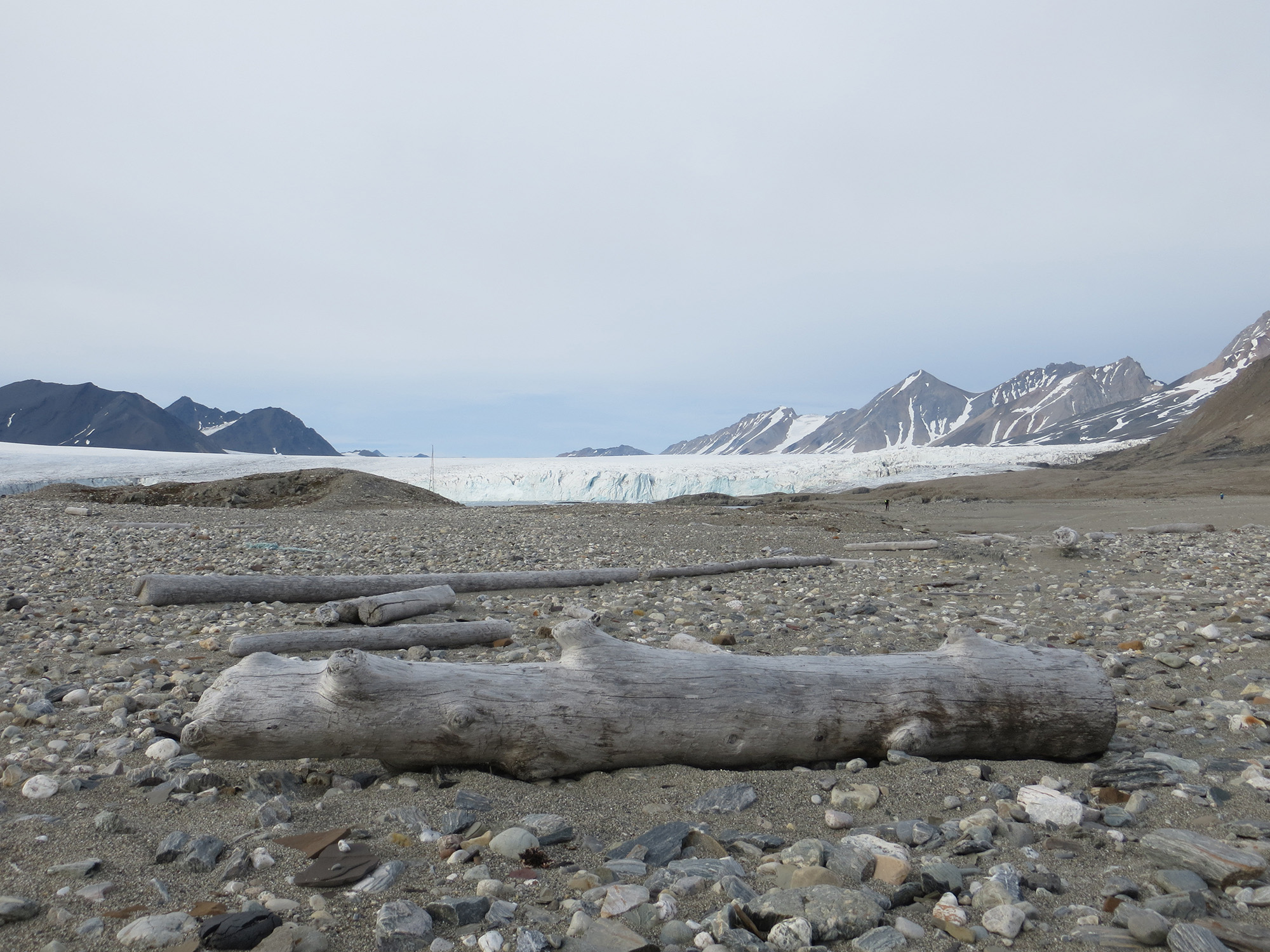how fragile and important the arctic climate system is
Interview with Hans Linderholm, University of GothenburgYou utilize driftwood to study the past climate of the Arctic – could you tell us more about this project?
We only have limited meteorological observations over short periods of time, that only cover part of the Arctic. That means, we are still lacking a detailed history of how climate in the whole Arctic region has changed under natural conditions. The only way of understanding how this climate system behaves without human impact, is by going way further back in time. Our research covers the Holocene, we know that driftwood has been found that was more than 10,000 years old. That means that since the last ice age, trees have been transported into the Arctic Ocean, got stuck in sea ice, drifted around and ended up on beaches in the Arctic. The aim of our research project is to use various kinds of information you can get from driftwood, to extend our knowledge of these past climate variations. Eventually, we want to combine this information with other archives like ice cores and ocean sediments, to train existing climate models, enabling them to predict the future more accurately.
How many driftwood samples did you collect and where?
I collected around 400 pieces of driftwood on different parts of Svalbard and we collected another couple of hundred samples in Northern Greenland. This project is ongoing and we hope to go on another expedition to Northern Greenland to collect more data. There are also existing collections of driftwood samples – like the ones of Ólafur Eggertsson from Skógræktin and my colleague Ulf Büntgen from the University of Cambridge. Eventually, we would like to merge all this data to have thousands of samples. The problem is that the majority of driftwood we find are logs from Russia, that were lost during timber floating in the 20th century. To find much older driftwood is tricky. As driftwood is such an important resource for fuel or building material in the Arctic, we have to find places where driftwood hasn’t been utilized and that’s a challenge.
Where do you find driftwood that is really old?
There has been an uplift of the land since the last ice age, because the islands were pressed down by this large ice sheet. That means what used to be the beach several thousand years ago is now elevated. If you visit the Arctic islands you will see high plateaus – these are the old beaches and we do find driftwood there that has been buried in sand or gravel. The higher driftwood is deposited, the older it should be. Radiocarbon data of driftwood from raised beaches has been used to date these terraces for quite a long time – so a piece of driftwood can tell you for instance, what the sea level used to be 3,500 years ago.

,Could you describe the different techniques of accessing the driftwood’s archive?
When we find a piece of wood we have no idea where it comes from at first, but usually we can say what kind of tree species it is by its look and smell. We mostly find conifers – spruce, pine and larch – and sometimes deciduous trees, but they are not as common. We measure the tree rings that form a pattern and then we take this tree ring pattern and compare it to reference samples from many different places around the Arctic. If we can match the ring pattern with trees that have grown by the Lena river in Siberia for example, we know it originates in that region. If we find a good match we can also date it. As soon as we know when and where it was living, we can roughly estimate how long the tree’s journey was. This is quite difficult though, because driftwood can beach hop around the Arctic – it may end up on one beach and when it has dried up, the waves may drag it back into the ocean and it floats to another beach.
In which cases do you use radiocarbon dating?
In order to be able to date a tree, we need a reference, which means someone had to take samples in different areas to build up a chronology. The time spans that these chronologies cover differ widely. Let’s say we have a reference chronology that spans a thousand years of a region in Russia, where a lot of driftwood originates. If we find a tree that is older than that, we can’t match it with the reference chronology so we don’t know its age. In this case we use radiocarbon dating. The radiocarbon values tell us how long the tree lived. When a tree dies, it can’t absorb any more radiocarbon, instead, the radiocarbon starts to decay. As we know the half-life of radiocarbon, we can then estimate how old the tree is and place it back in time for about 10,000 years. But in this case, we still wouldn’t know where the tree originated. So my vision is to extend the data we have today, by sampling as many old trees as possible, in order to gather information about tree growth from all around the Arctic, going several thousand years back in time. We can use this data to reconstruct climate conditions in those areas.
How exactly does driftwood tell you how currents and sea ice extent have changed?
A tree can’t just fall into a Siberian river, float into the ocean and travel all around the Arctic to end up in Iceland, Greenland or Svalbard. Its buoyancy is limited and in order to travel that far it needs to be frozen in sea ice, which is continuously moving and transported with the currents. When we look at the present currents we can identify the main floating patterns of sea ice. From other geological observations, we know that large currents like the Transpolar Current and the Beaufort Gyre, seem to shift depending on very warm or very cold conditions in the Arctic. Usually we have a strong Transpolar Current which is fed by ice from the Arctic shores. It flows across the Arctic, passes between Greenland and Svalbard and goes out into the North Atlantic. With these conditions, most of the driftwood we find in Iceland, Svalbard or Greenland originates in Russia.
But if the Beaufort Gyre was more powerful and the Transpolar Current shifted a bit, we would have a stronger influx of driftwood from Northern America. We found pieces of wood from Alaska that got stuck in the Beaufort Gyre, were eventually washed out into the Transpolar Current and deposited on Svalbard. So by looking at the trees’ origin and where they end up, we can estimate how ocean currents behaved. And if there’s very little or no sea ice, the probability of a tree actually reaching the Arctic is quite low, so you would expect to have much lower findings of driftwood. There have been studies suggesting that during the Holocene ice, conditions have varied a lot and have even been kind of similar to what we see today.

How would you compare the suitability of driftwood for past climate studies to sea ice or ocean sediment cores?
Sediment cores usually have a low resolution, because it takes a long time for these small particles to build up the sediments. Ice cores are a really good source but you can only get them in a few places. Driftwood provides annual information from different places and is quite straight forward to work with. What we started doing as well, to find out more about climate change in the past hundred years, is to study the tree rings of small shrubs that grow in the Arctic and can be quite old. By combining the information from driftwood, shrubs, oceanic sediments and ice cores, we get a much better idea about the complex Arctic climate system, than if we would only use one source.
We have never seen driftwood on open water – how does it look like?
When driftwood melts out, it of course has some time where it can actually float before it sinks. One time we were sailing from Longyearbyen on Svalbard to an island in the eastern part of the archipelago called Kongsøya, King’s Island. It took about 50 hours and we were sailing day and night so we had to have watches and you would see floating trees.
When I was on the icebreaker Oden in Northern Greenland, I suddenly spotted a floating piece of wood in the sea ice, a long stem which looked a bit brownish. I think the sea ice was about to melt because it was quite transparent. I told the captain that we needed to sample it and they sent out a small boat. But all of the sudden, there was lots and lots of ice and it just disappeared.
What do we know so far about the effects on our climate, of changing oceanic currents and receding sea ice in the Arctic?
There’s been a lot of debate on how the changing sea ice affects climate. Some scientists say changes in sea ice coverage affect the atmospheric circulation, which can then cause more extreme weather for instance. Sea ice also reflects sunlight, thus cooling the climate. Less sea ice means the solar radiation is absorbed by the Arctic ocean instead, heating it up. In a warmer Arctic, sea ice forms later in autumn and starts melting earlier in summer. Nowadays, it’s rare to find ice that has been building up for several years, so most of the sea ice is much thinner than it used to be. These are the causes why the Arctic is warming much faster than the rest of the world, creating new challenging conditions for ecosystems all around the region.
But a warmer Arctic also reduces the temperature gradient between the Equator and the Polar region, so we don’t have really cold and really warm air masses anymore which leads to changes in the winds and atmospheric circulation. The Jet Stream plays for instance, a really important role in transporting weather systems and usually moves high up in the atmosphere. But if the gradient is reduced, the Jet Stream is much slower and can get wavier, leading to weather conditions that are locked in one place for a long time. This happened for example when we experienced the 2018 heat wave. Changed conditions in the Arctic will most likely have an impact on a much larger scale, leading to more extreme weather both in summer and winter. That’s why it’s extremely important to understand causes and impacts of climate change in the Arctic.
Do you have a favorite driftwood story?
We were taking samples of driftwood on a beach in Northern Greenland, on a very sunny day. It was almost warm, so we wanted to go for a swim and put the samples in one place. The next day was really windy. We went to an island opposite of this beach – it’s Greenland, so the distances are huge. We were walking on the beach looking for driftwood and found a large piece that definitely looked like someone had taken a sample. This was a very remote area, the last people went there at the end of the last century and died. So we were wondering if there is a rival dendrochronologist sampling driftwood. But then we started to look closer and it turned out to be the same driftwood we had sampled the day before on the other beach. So clearly that was a case of beach hopping.
I think it’s amazing that driftwood travels from Russian or North American rivers with the sea ice and eventually melts out and ends up on a beach, instead of just sinking to the ocean floor. I’m so impressed by these trees, they really had a tough journey. That’s another reason why they should be celebrated and used for exciting research. By working with different archives in the Arctic, you realize how fragile and important the Arctic climate system is.

Hans Linderholm
Hans Linderholm is a professor at the Department of Earth Sciences at University of Gothenburg, Sweden. His research is focused on regional climate variability, especially in the Arctic and sub-Arctic, from the past (last 2000 years) to the future (next 100 years) and understanding the role of the large-scale circulation in the oceans and atmosphere on climate variability. Using high-resolution proxies, mainly tree rings, he reconstructs past climate variations on different temporal and spatial scales.